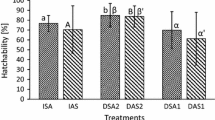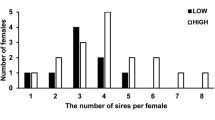Abstract
We investigated the mating and fertilization patterns in one Czech local population of the invasive aphidophagous ladybird Harmonia axyridis (Pallas), sampling the same mixed generations before and after overwintering. Our study using eight microsatellite loci provides the first direct evidence that females of H. axyridis are highly polyandrous in the wild and that they not only mate multiple times but also use the sperm from multiple males to fertilize their eggs. Three types of values (minimum number of fathers, estimated number of fathers and effective number of fathers contributing to progeny of one mother) were about two times higher in the spring sample (2.9, 5.2, 3.1), in the peak of their reproduction period, than in the preceding autumn sample (1.6, 2.8, 1.6). The contribution of individual fathers to the number of progeny was highly unbalanced, with a few dominating fathers and many fathers with low number of progeny.

Similar content being viewed by others
References
Arnaud L, Spinneux Y, Haubruge E (2003) Preliminary observations of sperm storage in Adalia bipunctata (Coleoptera: Coccinellidae): sperm size and number. Appl Entomol Zool 38:301–304
Arnqvist G, Nilsson T (2000) The evolution of polyandry: multiple mating and female fitness in insects. Anim Behav 60:145–164
Awad M, Kalushkov P, Nedvědová T, Nedvěd O (2013) Fecundity and fertility of ladybird beetle Harmonia axyridis after a prolonged cold storage. Biocontrol 58:657–666
Bayoumy MH, Michaud JP (2014) Female fertility in Hippodamia convergens (Coleoptera: Coccinellidae) is maximized by polyandry, but reduced by continued male presence. Eur J Entomol 111:513–520
Brown PMJ, Roy HE, Rothery P, Roy DB, Ware RL, Majerus MEN (2008) Harmonia axyridis in Great Britain: analysis of the spread and distribution of a non-native coccinellid. Biocontrol 53:55–67
Brown PMJ, Thomas CE, Lombaert E, Jeffries DL, Estoup A, Handley LJL (2011) The global spread of Harmonia axyridis (Coleoptera: Coccinellidae): distribution, dispersal and routes of invasion. Biocontrol 56:623–641
Ceryngier P, Kindlmann P, Havelka J, Dostalkova I, Brunnhofer V, Hodek I (1992) Effect of food, parasitization, photoperiod and temperature on gonads and sexual activity of males of Coccinella septempunctata (Coleoptera, Coccinellidae) in autumn. Acta Entomol Bohemoslov 89:97–106
Ceryngier P, Havelka J, Hodek I (2004) Mating and activity of gonads in pre-dormant and dormant ladybirds (Coleoptera: Coccinellidae). Invertebr Reprod Develop 45:127–135
Chapuis M, Estoup A (2007) Microsatellite null alleles and estimation of population differentiation. Mol Biol Evol 24:621–631
Choe JC, Crespi BJ (1997) The evolution of mating systems in insects and arachnids. Cambridge University Press, Cambridge
de Jong PW, Verhoog MD, Brakefield PM (1993) Sperm competition and melanic polymorphism in the 2-spot ladybird, Adalia bipunctata (Coleoptera, Coccinellidae). Heredity 70:172–178
de Jong PW, Brakefield PM, Geerinck BP (1998) The effect of female mating history on sperm precedence in the two-spot ladybird, Adalia bipunctata (Coleoptera, Coccinellidae). Behav Ecol 9:559–565
Dempster AP, Laird NM, Rubin DB (1977) Maximum likelihood from incomplete data via the EM algorithm. J Roy Stat Soc B 39:1–38
Eberhard WG (1996) Female control: sexual selection by cryptic female choice. Princeton University Press, Princeton
Estoup A, Largiader CR, Perrot E, Chourrout D (1996) Rapid one-tube DNA extraction for reliable PCR detection of fish polymorphic markers and transgenes. Mol Mar Biol Biotech 5:295–298
Galvan TL, Koch RL, Hutchison WD (2008) Impact of fruit feeding on overwintering survival of the multicolored Asian lady beetle, and the ability of this insect and paper wasps to injure wine grape berries. Entomol Exp Appl 128:429–436
Garcia C, Arroyo JM, Godoy JA, Jordano P (2005) Mating patterns, pollen dispersal, and the ecological maternal neighbourhood in a Prunus mahaleb L. population. Mol Ecol 14:1821–1830
Glaubitz J (2004) Convert: a user-friendly program to reformat diploid genotypic data for commonly used population genetic software packages. Mol Ecol Notes 4:309–310
Haddrill PR, Shuker DM, Amos W, Majerus MEN, Mayes S (2008) Female multiple mating in wild and laboratory populations of the two-spot ladybird, Adalia bipunctata. Mol Ecol 17:3189–3197
Haddrill PR, Majerus MEN, Shuker DM (2013) Variation in male and female mating behaviour among different populations of the two-spot ladybird, Adalia bipunctata (Coleoptera: Coccinellidae). Eur J Entomol 110:87–93
Hodek I, Ceryngier P (2000) Sexual activity in Coccinellidae (Coleoptera): a review. Eur J Entomol 97:449–456
Jones O, Wang J (2009) Colony: a program for parentage and sibship inference from multilocus genotype data. Mol Ecol Res 10:551–555
Kajita Y, O’Neill EM, Zheng YB, Obrycki JJ, Weisrock DW (2012) A population genetic signature of human releases in an invasive ladybeetle. Mol Ecol 21:5473–5483
Laugier GJM, Le Moguédec G, Tayeh A, Loiseau A, Osawa N, Estoup A, Facon B (2013) Increase in male reproductive success and female reproductive investment in invasive populations of the Harlequin ladybird Harmonia axyridis. PLoS ONE 8:e77083. doi:10.1371/journal.pone.0077083
Loiseau A, Malausa T, Lombaert E, Martin J, Estoup A (2009) Isolation and characterization of microsatellites in the harlequin ladybird, Harmonia axyridis (Coleoptera, Coccinellidae), and cross-species amplification within the family Coccinellidae. Mol Ecol Res 9:934–937
Lombaert E, Guillemaud T, Lundgren J, Koch R, Facon B, Grez A, Loomans A, Malausa T, Nedved O, Rhule E, Staverlokk A, Steenberg T, Estoup A (2014) Complementarity of statistical treatments to reconstruct worldwide routes of invasion: the case of the Asian ladybird Harmonia axyridis. Mol Ecol 23:5979–5997. doi:10.1111/mec.12989
Majerus MEN (2009) Ladybugs. In: Resh VH, Cardé RT (eds) Encyclopedia of insects. Academic Press, Waltham, pp 547–551
Majerus TMO, Majerus MEN (2012) Male-killing in the Coccinellidae: testing the predictions. Evol Ecol 26:207–225
McCornack BP, Koch RL, Ragsdale DW (2007) A simple method for in-field sex determination of the multicolored Asian lady beetle Harmonia axyridis. J Insect Sci 7:10
Michaud JP, Bista M, Mishra G, Omkar (2013) Sexual activity diminishes male virility in two Coccinella species: consequences for female fertility and progeny development. Bull Entomol Res 103:570–577
Nalepa CA, Kidd KA, Ahlstrom KR (1996) Biology of Harmonia axyridis (Coleoptera; Coccinellidae) in winter aggregations. Ann Entomol Soc Am 89:681–685
Nedvědová T, Awad M, Ungerová D, Nedvěd O (2013) Characteristics of ladybird Harmonia axyridis during autumn migration. IOBC–WPRS Bull 94:117–122
Omkar, Mishra G (2005) Mating in aphidophagous ladybirds: costs and benefits. J Appl Entomol 129:432–436
Osawa N (1994) The occurrence of multiple mating in a wild population of the ladybird beetle Harmonia axyridis Pallas (Coleoptera, Coccinellidae). J Ethol 12:63–66
R Core Team (2012) R: a language and environment for statistical computing. R foundation for statistical computing, Vienna, Austria. http://www.R-project.org/. ISBN 3-900051-07-0
Sakai AK, Westneat DF (2001) Mating systems. In: Roff DA, Fairbairn DJ, Fox CW (eds) Evolutionary ecology: concepts and case studies. Oxford University Press, Oxford, pp 193–206
Savoiskaya GI (1970) Coccinellids of the Alma-Ata reserve. Trudy Alma-Atinskogo Gosudarstvenogo Zapovednika 9:163–187 (in Russian)
Simmons LW (2001) Sperm competition and its evolutionary consequences in the insects. Princeton University Press, Princeton
Sloggett JJ, Honěk A (2012) Genetic studies. In: Hodek I, van Emden H, Honěk A (eds) Ecology and behaviour of the ladybird beetles (Coccinellidae). Wiley-Blackwell, Oxford, pp 13–53
Tayeh A, Estoup A, Laugier G, Loiseau A, Turgeon J, Toepfer S, Facon B (2012) Evolution in biocontrol strains: insight from the harlequin ladybird Harmonia axyridis. Evol Appl 5:481–488
Thornhill R, Alcock J (1983) The evolution of insect mating systems. Harvard University Press, Cambridge
Ueno H (1994) Intraspecific variation of P2 value in a coccinellid beetle, Harmonia axyridis. J Ethol 12:169–174
Ueno H (1996) Estimate of multiple insemination in a natural population of Harmonia axyridis (Coleoptera: Coccinellidae). Appl Entomol Zool 31:621–623
Watson PJ (1991) Multiple paternity as genetic bet-hedging in female sierra dome spiders, Linyphia litigiosa (Linyphiidae). Anim Behav 41:343–360
Watson PJ, Arnqvist G, Stallmann RR (1998) Sexual conflict and the energetic costs of mating and mate choice in water striders. Am Natur 151:46–58
Yasui Y (1998) The ‘genetic benefits’ of female multiple mating reconsidered. Trends Ecol Evol 13:246–250
Acknowledgments
The study was supported by grant no. QH82047 from the Ministry of Agriculture of the Czech Republic and by a grant from the Agropolis Fondation (RTRA—Montpellier, BIOFIS project). All molecular data were generated at the molecular genetic analysis technical facilities of the Environment and Biodiversity IFR 119 at Montpellier (France). We are grateful to John Sloggett, Ivo Hodek, Pavel Kindlmann and four reviewers of the previous version of the manuscript for their valuable comments and corrections.
Author information
Authors and Affiliations
Corresponding author
Rights and permissions
About this article
Cite this article
Awad, M., Laugier, G.J.M., Loiseau, A. et al. Unbalanced polyandry in wild-caught ladybirds Harmonia axyridis (Coleoptera: Coccinellidae). Appl Entomol Zool 50, 427–434 (2015). https://doi.org/10.1007/s13355-015-0348-5
Received:
Accepted:
Published:
Issue Date:
DOI: https://doi.org/10.1007/s13355-015-0348-5




